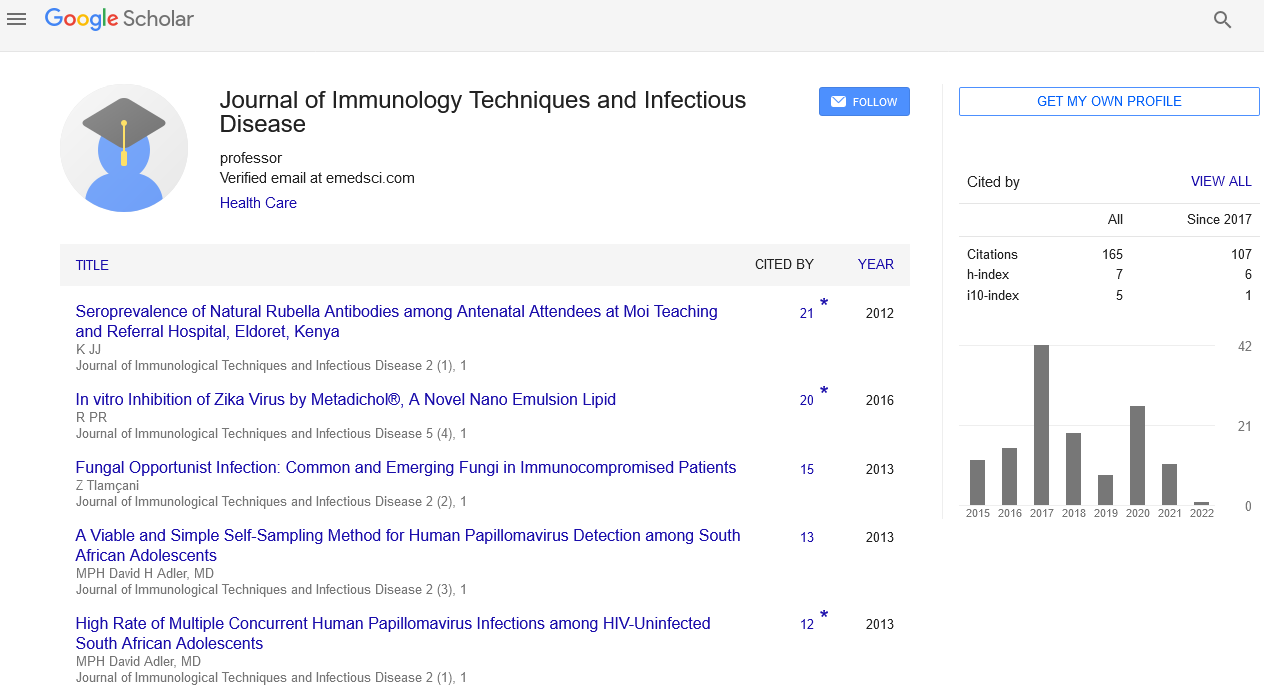Opinion Article, J Immunol Tech Infect Dis Vol: 13 Issue: 1
Structure and Ecological Implications of Bacteria
Aljabali Tanani*
1Department of Infection Disease, Yarmouk University, Irbid, Jordan
*Corresponding Author: Aljabali Tanani,
Department of Infection Disease,
Yarmouk University, Irbid, Jordan
E-mail: tana.alijab@gmail.com
Received date: 01 March, 2024, Manuscript No. JIDIT-24-135308;
Editor assigned date: 04 March, 2024, PreQC No. JIDIT-24-135308 (PQ);
Reviewed date: 18 March, 2024, QC No. JIDIT-24-135308;
Revised date: 26 March, 2024, Manuscript No. JIDIT-24-135308 (R);
Published date: 04 April, 2024, DOI: 10.4172/2329-9541.1000375.
Citation: Tanani A (2024) Structure and Ecological Implications of Bacteria. J Immunol Tech Infect Dis 13:1.
Description
Bacteria, the prevalent microorganisms inhabiting every corner of the planet, represent one of the oldest and most diverse forms of life. From the depths of the ocean floor to the soils fundamental feet and within the intricate ecosystems of the bodies, bacteria play fundamental roles in shaping the world.
Bacterial diversity: A microscopic universe
Bacteria comprise a significant and diverse group of single-celled organisms with remarkable adaptability to various environments. Their diversity encompasses a wide range of morphological, physiological, and metabolic characteristics, allowing them to increase in diverse habitats ranging from extreme environments such as hot springs and deep-sea hydrothermal vents to more familiar settings such as soil, water, and the human body. Bacterial diversity is further reflected in their many organisms are probably have not been identified and characterized in terms of their genetic structure.
Cellular structure: Building blocks of bacterial life
The cellular structure of bacteria is relatively simple compared to eukaryotic organisms; it is finely tuned to support their survival and proliferation. Bacterial cells are typically prokaryotic, lacking a true nucleus and membrane-bound organelles. However, they control a single circular chromosome and frequently carry extra chromosomal DNA in the form of plasmids. Surrounding the bacterial cell is a painful cell wall which provides structural support and protection from osmotic stress. Some bacteria also possess additional outer layers such as capsules or slime layers, which aid in adherence, evasion of immune responses, and biofilm formation.
Metabolic diversity: Masters of metabolism
Bacteria exhibit an array of metabolic capabilities, allowing them to utilize diverse energy sources and carbon substrates for growth and survival. Bacteria can be classified based on their energy and carbon source utilization into categories such as autotrophs, heterotrophs, phototrophs, and chemotrophs. Additionally, bacteria can engage in a wide range of metabolic processes, including fermentation, respiration, nitrogen fixation, and photosynthesis, contributing to nutrient cycling, soil fertility, and ecosystem productivity.
Ecological significance: Guardians of the biosphere
Bacteria play essential roles in virtually every ecosystem on Earth, contributing to biogeochemical cycles, nutrient recycling, and the maintenance of ecological balance. In soil ecosystems, bacteria participate in organic matter decomposition, nitrogen fixation, and plant-microbe interactions, influencing soil fertility and plant health. In aquatic environments, bacteria are important players in carbon and nutrient cycling, contributing to water quality and ecosystem stability. Additionally, bacteria form symbiotic relationships with plants, animals, and other microorganisms, facilitating mutualistic interactions and ecosystem resilience.
Beneficial bacteria: Allies in health and industry
While some bacteria are associated with infectious diseases, many bacterial organisms are beneficial to humans and the environment. Beneficial bacteria inhabit the human body, forming the microbiota of the skin, oral cavity, gastrointestinal tract, and other mucosal surfaces. These commensal and symbiotic bacteria contribute to host health by aiding digestion, synthesizing vitamins, modulating immune responses, and preventing colonization by pathogenic microorganisms. In addition to their roles in human health, bacteria have immense industrial applications, including food fermentation, bioremediation, wastewater treatment, and biopharmaceutical production.
Pathogenic bacteria: Agents of disease and disruption
Despite their ecological and industrial significance, some bacteria are pathogens capable of causing infectious diseases in humans, animals, and plants. Pathogenic bacteria utilize a variety of virulence factors, including toxins, adhesins, and secretion systems, to colonize host tissues, evade immune responses, and cause tissue damage. Common bacterial pathogens include Escherichia coli, Staphylococcus aureus, Streptococcus pneumoniae, and Mycobacterium tuberculosis, which are responsible for diseases ranging from food poisoning and pneumonia to tuberculosis and sepsis.
 Spanish
Spanish  Chinese
Chinese  Russian
Russian  German
German  French
French  Japanese
Japanese  Portuguese
Portuguese  Hindi
Hindi 
